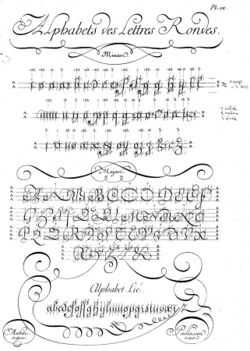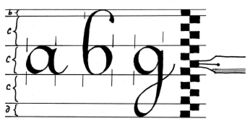Social:Ronde script (calligraphy)
Ronde ('round' in French) is a kind of script in which the heavy strokes are nearly upright, giving the characters when taken together a round look.[1]
Ronde script appeared in France at the end of the 16th century, and was popularized by writing masters such as Louis Barbedor in the 17th century. In its original form, it borrowed some of its letterforms from the round Gothic style. This style of writing was still in use (with some modifications) until the 20th century because it was used in French school manuals to teach the bases of cursive writing. It was also commonly used by the scribes of the French Ministry of Finance until right after World War II,[2] which gave this style the name of écriture ronde finnancière ('round financial writing', not to be confused with the financière writing style).[3]
The classic French rondes where also very present in the work of 18th century type founder and calligrapher Nicholas Gando, which has been revived for the digital medium by way of the French 111 font.[4]
Notes and references
- ↑ (in English) Webster's Dictionary. 1913.
- ↑ Smith, Marc H. (2008). "Du manuscrit à la typographie numérique : présent et avenir des écritures anciennes". Gazette du Livre Médiéval (French National Centre for Scientific Research) (52-53): 51–78. https://halshs.archives-ouvertes.fr/halshs-00646804/.
- ↑ Nesbitt, Alexander (1957). The history and technique of lettering. New York: Dover Publications. ISBN 9780486204277. OCLC 654540. https://www.worldcat.org/oclc/654540.
- ↑ Published by the Bitstream type foundry in 1970.



